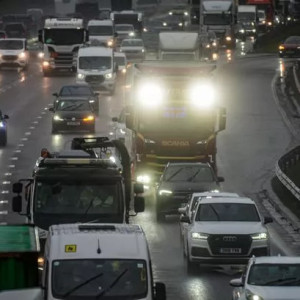Highways England ‘set to remove’ M6 and M5 motorway lights to hit carbon emissions targets

Exclusive: Plan goes ahead even after an earlier initiative to switch off lights was scrapped in 2019 due to an accident surge
14:53, 12 May 2025Updated 15:08, 12 May 2025
 Lights are set to be permanently removed on the M5 and M6 through Birmingham if a Highways England trial is successful(Image: Getty Images)
Lights are set to be permanently removed on the M5 and M6 through Birmingham if a Highways England trial is successful(Image: Getty Images)
Officials at Highways England are preparing to give the red light to more than 140 miles of motorway illumination across some of Britain's busiest stretches in a bid to reduce carbon emissions, including the M6 and M5 through Birmingham[1].
The controversial move has come to light following a parliamentary question. Despite concerns, Highways England is pushing ahead even after an earlier initiative to switch off lights was scrapped in 2019 due to an uptick in accidents.
Highways England disclosed that it's currently piloting the blackout of specific road segments with the intention of eventually taking out the lights for good. During this test phase, they'll measure the accident rate against data from the past five years, and if the analysis gives the green light, those lights will be switched off permanently.
As of now, two long stretches lie in darkness: one spans from the M6 Keele Bank services down to Strensham Services on the M5--summing up to approximately 91 miles of critical highway--and another covers the gap from the M27 J12 to the M3 J13, totalling about 54 miles.
The matter was thrust into the spotlight by Conservative Rebecca Paul through a formal written question to Transport Secretary Heidi Alexander inquiring: "What recent discussions she has had with National Highways on its programme of (a) turning off and (b) removing lights on motorways."
Parliamentary Under-Secretary of State for Future of Roads Lilian Greenwood replied, saying the change was being made to hit net zero targets: "The Department meets monthly with National Highways to discuss its performance and delivery.
This includes discussions on the company's actions to meet its Key Performance Indicator targets, one of which is Corporate Carbon reduction.
Article continues below"Electricity used to light the strategic road network is by far the biggest contributor to National Highways' overall carbon emissions. To meet the reduction target, National Highways has been trialling turning off some sections of lighting, where it has been assessed safe to do so, alongside its LED replacement programme."
A National Highways spokesperson said: "Safety is our priority and any decision to remove lighting is fully researched and carefully considered. This allows us to use taxpayers money on improving other elements of the road network that bring greater safety benefits for drivers while reducing our carbon output."
The organisation, which oversees around 4,500 miles of motorways and major A-roads in England, is conducting a year-long trial switch-off on sections of the motorway before considering lighting removal, comparing against nighttime casualty figures from the past five years.
With plans to convert 70% of street lighting assets to LED by 2027, all road sections are under review for potential light removal.
This follows a previous initiative between 2009 and 2019 when motorway lighting was turned off between midnight and 5am on approximately 100 miles of the network, with some lights remaining off entirely.
A Highways England report examined reported road casualties during this period.
According to the report, the number of casualties on previously unlit sections that had been lit rose by 88% (from 93 to 175) between 2010 and 2017.
.In 2019, it was revealed that Highways England had stopped turning off motorway lights at midnight since 2018, citing the installation of LED lighting as the reason.
Richard Leonard, Head of Road Safety, stated at the time: 'Safety is our top priority. On our roads, we light what needs to be lit, and we know where those locations are. We have a better understanding of where nighttime collisions occur and the impact road lighting would have.
This means we can target lighting where it is needed, rather than putting lights everywhere."
"We are absolutely committed to further reducing deaths and injuries on England's motorways and major A roads.
This will require a concerted effort and investment over the long term."
Article continues belowHighways England noted that data suggested a higher likelihood of being involved in a casualty incident on a lit section of road, although pointed out this may be due to the fact that lighting is often installed on more hazardous sections of the network.
References
- ^ Birmingham (www.birminghammail.co.uk)